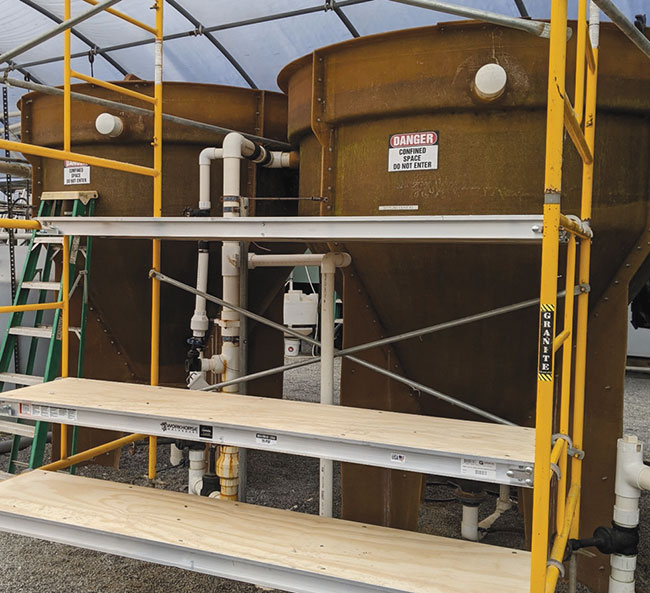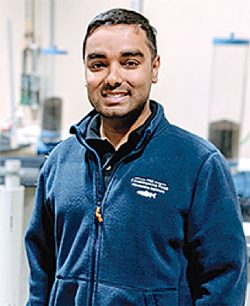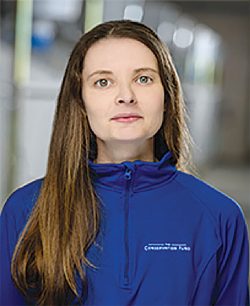
Features
Anaerobic digestion of sludge from RAS: Challenges and potential solutions
December 16, 2021 By Abhinav Choudhury and Christine Lepine
 Gravitational settling cones for thickening waste RAS solids at The Conservation Fund Freshwater Institute. Photo: The Conservation Fund Freshwater Institute.
Gravitational settling cones for thickening waste RAS solids at The Conservation Fund Freshwater Institute. Photo: The Conservation Fund Freshwater Institute. Recirculating aquaculture systems (RAS) offer several advantages for fish farmers. Most notably, RAS provide enhanced control of the culture environment, reduce land and water use, and provide increased biosecurity, while also maximizing fish growth performance. Recirculating technology has developed highly effective waste capture and collection systems to maintain optimal water quality. Once removed from the recirculation loop, however, waste solids must be managed, and are currently considered an operation expense. The generated sludge, consisting primarily of fecal matter and uneaten feed, is, in reality, a valuable resource due to its high organic matter, nitrogen, and phosphorus content.
Through the process of anaerobic digestion (AD), organic matter in aquaculture waste can be transformed into a renewable energy resource. The AD process results in the microbial breakdown of the complex organic molecules in the sludge, producing highly valuable biogas, a mixture of methane (CH4) and carbon dioxide (CO2) with other trace gases such as hydrogen sulfide (H2S) and ammonia (NH3). Even though AD processes have been used extensively for manure management on terrestrial animal farms and in the wastewater treatment industry for human sludge, its utilization in RAS has not been fully explored. Early research has provided insights into the unique challenges that may inhibit RAS sludge digestion, some of which are highlighted below.
Sludge thickening
Dilute wastewater streams, such as backwash from drum filters, may lack sufficient alkalinity and organic matter for an efficient digestion process in complete-mix and plug flow digesters. The waste sludge may need to undergo dewatering and sludge thickening to increase the solids content. Alkalinity can also be raised through the addition of bicarbonate, which can help prevent sudden drops in pH, as it enhances buffering capacity. Existing sludge dewatering and thickening technologies on RAS farms (e.g., gravitational thickening settlers, geotextile bag filters, inclined belt filters, or membrane reactors) can be used to achieve a solids concentration of 5 to 22 per cent (Sharrer et al. 2009). It should be noted that the dilute wastewater may be anaerobically digested without thickening by using different reactor designs, such as high-rate fixed-film or up-flow anaerobic sludge blanket (UASB) bioreactors.
Carbon/nitrogen (C/N) ratio and ammonia
The feedstock C/N ratio is an important parameter measuring the fraction of the organic matter utilized for energy production and cell synthesis. Microorganisms use carbon as an energy source and nitrogen for the synthesis of proteins and nucleic acids. Fish waste solids generally have a low C/N ratio, resulting in lowered CH4 production due to limited carbon availability and elevated ammonia concentrations. The breakdown of nitrogen-containing organic compounds, such as proteins, leads to ammonia formation inside an AD system. Ammonia can exist in two forms (ammonium ion, or NH4+, and free ammonia, or NH3) inside the digester, depending on the pH of the sludge. As the pH increases (>pH8), ammonium ions are rapidly converted to toxic-free ammonia, destabilizing the AD process, and resulting in low CH4 production. Fish waste solids can also contain elevated amounts of total nitrogen (approx. 10 to 30 per cent dry matter depending on the fish type and feed) that can mineralize into ammonia within the digester (van Rijn, 2013). Potential solutions include waste sludge dilution, adding co-digestion substrates high in carbon but low in nitrogen balancing the C/N ratio, and utilizing a microbial source adapted to these conditions.
Volatile fatty acids
The breakdown of organic matter in an AD system results in the formation of organic acids containing two to six carbon atoms (collectively known as VFAs). The synergistic activity of different microorganisms within the AD system results in continuous production and consumption of VFAs. However, if the VFAs are not consumed by the methane producers due to inhibitory conditions (e.g., excess ammonia) or if the rate of VFA production far exceeds its consumption rate (overloading the digester with organics), it may significantly lower the digester pH, especially in a system without adequate alkalinity. A pH lower than 6.5 may kill off all the methane producers, resulting in a ‘crash’ of the AD system. Conversely, dilute RAS sludge may result in low VFA production, thereby resulting in low CH4 production (Manchala et al., 2017). Sufficient sludge thickening, appropriate organic loading rates, and the addition of co-digestion substrates may be effective strategies to minimize VFA complications.
Salinity
One of the primary challenges of brackish and saline waste is sodium ion (Na+) inhibition, resulting in dehydration and cell lysis of unacclimated microbes. Excess salinity can also negatively affect the metabolism of acid-producing microorganisms, leading to VFA accumulation and acidic conditions, which are detrimental to the stable functioning of methanogens. Although, recent research has demonstrated that using osmoprotectants to protect microbial cells from dehydration and cell lysis, may be a promising solution (Zhang et al., 2014). Additionally, utilizing microbial sources adapted to highly saline marine environments may provide another level of protection (Quinn et al., 2016).
Hydrogen sulfide
Elevated concentrations of sulfate (SO42-) in brackish and seawater can also inhibit methane production due to excess H2S production. At higher salinities (>15 g/L), H2S concentrations can be in excess of 15,000 ppm. High concentrations lead to inhibitory conditions for the methane producers, thereby increasing the duration of the startup phase. More concerning is that high H2S concentrations lead to issues during energy generation. An upper limit of 500 ppm for H2S is recommended for most generators utilizing biogas for electricity production. As a result, RAS farms may require additional capital and operating costs for desulfurizing the biogas before its use. Commercially available H2S scrubbing solutions are generally effective in reducing H2S concentrations to below the recommended limits.
With increased investment in land-based RAS production facilities worldwide, waste management and treatment will require additional research to ensure RAS sustainability. Ongoing research has shown potential in using AD processes to treat RAS sludge while providing energy recovery via methane production, but its feasibility is yet to be determined. The Conservation Fund Freshwater Institute, located in Shepherdstown, W.Va., USA, is currently addressing some of the aforementioned challenges to the AD of RAS sludge. To learn more, visit https://www.conservationfund.org/our-work/freshwater-institute/our-projects.
References
- Sharrer, M.J., Rishel, K. and Summerfelt, S., 2009. Evaluation of geotextile filtration applying coagulant and flocculant amendments for aquaculture biosolids dewatering and phosphorus removal. Aquacultural Engineering, 40(1), pp.1-10.
- Van Rijn, J., 2013. Waste treatment in recirculating aquaculture systems. Aquacultural Engineering, 53, pp.49-56.
- Manchala, K.R., Sun, Y., Zhang, D. and Wang, Z.W., 2017. Anaerobic digestion modelling. In Advances in Bioenergy (Vol. 2, pp. 69-141). Elsevier.
- Zhang, X., Hu, J., Spanjers, H. and van Lier, J.B., 2014. Performance of inorganic coagulants in treatment of backwash waters from a brackish aquaculture recirculation system and digestibility of salty sludge. Aquacultural Engineering, 61, pp.9-16.
- Quinn, B.M., Apolinario, E.A., Gross, A. and Sowers, K.R., 2016. Characterization of a microbial consortium that converts mariculture fish waste to biomethane. Aquaculture, 453, pp.154-162.
 Abhinav Choudhury, PhD, is an environmental research engineer at the Freshwater Institute. He is responsible for research on investigation of strategies for improving the environmental impact and economic viability of intensive land-based aquaculture production, providing waste management and waste conversion expertise for external projects, and assisting industry partners with problems related to waste management and waste conversion.
Abhinav Choudhury, PhD, is an environmental research engineer at the Freshwater Institute. He is responsible for research on investigation of strategies for improving the environmental impact and economic viability of intensive land-based aquaculture production, providing waste management and waste conversion expertise for external projects, and assisting industry partners with problems related to waste management and waste conversion.
 Christine Lepine is a research associate at the Conservation Fund’s Freshwater Institute, focusing on effluent water quality and wastewater management of recirculating aquaculture systems (RAS). Lepine holds an M.S. in Natural Resources and Environmental Science.
Christine Lepine is a research associate at the Conservation Fund’s Freshwater Institute, focusing on effluent water quality and wastewater management of recirculating aquaculture systems (RAS). Lepine holds an M.S. in Natural Resources and Environmental Science.
Print this page
Advertisement
- Scottish Sea Farms’ bid to acquire Grieg Seafood Hjaltland UK, moves forward
- Parental selection critical in European sea bass female-to-male ratio production





